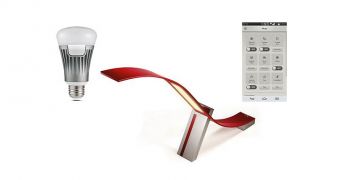LG first used its curved OLED display technology in some concept curved phones and the like, at previous trade shows, but it is now exploring other possibilities, specifically those of general lighting applications.
Case in point, at the Light+Building show in Frankfurt, Germany, LG brought the "OLED Table Lamp," the first lamp that uses curved OLED tech as a light source.
Clearly, the company is looking at the rich people who value aesthetics and don't scowl at expenses.
OLED technology is expensive even in its normal, straight form, but curved OLED adds a new dimension to things.
LG didn't completely discount mobile electronics though, even now. The OLED may not have been used in a phone or tablet, but it can still be controlled by one.
To elaborate, the company included a remote control technology, which allows a smartphone or tablet to define lighting modes.
There's a "movie" mode, a "relax" mode and various other settings. You can even manually dim the light, or intensify it based on your mood and needs.
Obviously, an app will be needed, but it should show up on the Google Play store soon, if it hasn't already, free of charge.
There is no true need for the lamp to have a curved OLED screen, and we're fairly certain that LG could have come up with some intricate designs even if it used normal OLED lights.
Nevertheless, despite LG's attempts at marketing its curved OLED technology, there just hasn't been much success, which is why the outfit is doing this now.
The OLED Table Lamp is the first of its kind, but it won't be the last. All that remains is for LG and whoever else deals or will deal in curved OLED tech, to find a way to reduce the price.
LG didn't say how much money the OLED Table Lamp sells for. It didn't even say for certain if it will even be put up for sale at some point in the future.
Smart lighting will definitely take off though, with or without curved OLED panels. It's part of the Internet of Things initiative after all, which aims to link every technological device in the home to a cloud server, or to a home server.
The homes of tomorrow will let you turn lights on or off, adjust intensity, use them as access points, of sorts, to send commands to other appliances, etc. Kind of like IT giants have promised to, say, enable you to keep tabs on your washing machine and send commands to it through your TV.

 14 DAY TRIAL //
14 DAY TRIAL //